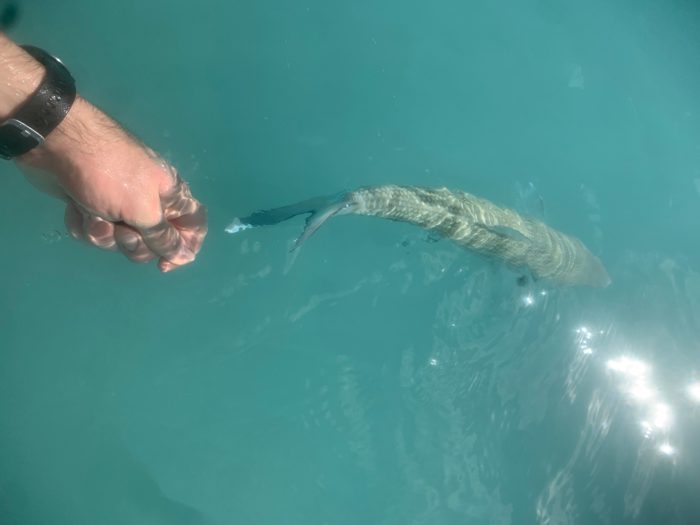
The Bonefish of Exuma
Hey everyone, I recently got back from an awesome trip to the Bahamas Great Exuma Island chasing after bonefish for the first time. It was a fun time, but definitely different for me as usual when I travel to fish for a competition or practice. Unlike the fast paced and focused trips I usually take, everything about the Bahamas is slow paced and relaxing. At least until a bonefish decides to eat your fly and then swim to Europe. Now that I’m back and in my class routine for this semester, I figured I would give a write up of the highlights of my trip, as well as a sort of travel guide for anyone who wants to give the bonefishing a shot on exuma.
Great Exuma Island is a small island near the middle of the Bahama chain. It’s only about 37 miles long, and Queens Highway follows its north shore for the entire length. I landed in the morning at Exuma airport, got a rental car, picked up groceries, and ended up standing on the beach with a rod in hand before the sun started going down. I rented from Hideaways, a larger resort on the north side of the island, which has a decent beach right in front of it with a small flat that extends out for about 50 yards. I didn’t see any bonefish there my first night, which foreshadowed my entire experience DIYing it on the island’s north side.
I woke up at 7 am the next day to give it a second go with a local guide named Herman. He picked me up from my place, and we drove five minutes down the road to his boat. We were fishing on the north side, which was characterized by generally deeper water, smaller flats, and more sharp limestone outcroppings. It is also less protected from the weather, and as we were launching I noticed it had gotten much windier than the previous day due to a cold front pushing through. We had cloudy skies and sustained 20+ MPH winds with an occasional harder gust for the whole day, which made spotting fish and casting more difficult than I was hoping. The weather didn’t put too much of a damper on the day though, as after a short boat ride to a cluster of tiny islands on the north side, I cast to and subsequently missed my first bonefish.
We started off fishing to a steep drop off in front of a small beach, using heavier lead eye flies and long leaders to reach the fish in around 10 feet of water. I would spot the school by waiting for a flash, cast out to it, and wait 10-15 second for the fly to reach the bottom and anchor. I felt like I was loch style fishing a lake at this point; cast, count the flies down, and strip it back with uniform 9 inch strips. After a few more minutes another fish ate, and I continued stripping at the same pace just like with a trout eat in a lake. After two more strips, I felt the fish’s weight and it took off. I’ll be the thousandth person to say it, but pound for pound bonefish are surely the hardest fighting fish I’ve caught. My first fish ended up being a solid mid twenty incher that put up a good five minute fight. We stayed in that spot, which produced four more fish, for another half hour before moving on to try and find fish in shallower water to sight fish to.
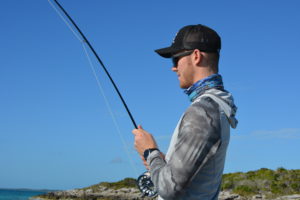
Hooked up with my first fish from the deep water.
We found what we were looking for in a small lagoon near an island called Crab Cay. It was a very shallow area ringed with mangroves that we got to as the mornings high tide was going out. After switching to a lighter and smaller beadchain version of my fly, we stepped out of the boat and began walking the perimeter in search of tailing fish. Walking along the mangroves, I had my first of many encounters with rays and lemon sharks. When we walked to the end of the mangroves, we started back to the boat, but midway there I spotted two fish working towards us in a channel. I quickly stripped off line and made a cast about ten feet short so that the fly could settle and be in position before they got there. When the fish were less than a foot away I made two short, slow strips and they both immediately darted toward it. The larger of the two ate and I stripped into it, quickly feeling its weight on the line and realizing that it was much larger than the others I had caught. Within seconds it had shot back down the channel and had me into the start of my backing. Then, all of the sudden, the line went limp. I still don’t know what happened, but by far the largest fish of my trip just popped off.
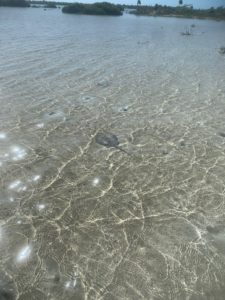
A small ray in the lagoon.
Though I never got to land it, the eat and fight with that fish are one of the highlights of my trip. We fished the north side for the rest of the day and I ended up catching six or seven more, but none of any great size. Right as my day on the boat was coming to an end, I hooked up with one more nice fish. I fought it for a few seconds and then the line went limp. I thought it just popped off, but then a massive shape came to the surface. I thought it was a shark, however then realized it was a massive barracuda that had just taken my fish. Herman said that it was one of, if not the, biggest barracuda he had ever seen. I was sad to see my fish get demolished, but amazing to see an apex predator that size at work.
I had Herman booked for the next day as well, so we decided to hit the south side of the island. This was where large famous flats and enormous schools of bones that the Bahamas is famous for were, so I was biting at the bit to see it. We motored up to a large mangrove shore and anchored the boat. We got there just as the tide was starting to rise in hopes that we could cut off the schools before as they tried to get back into the mangroves to feed on high tide. We quickly came across a smaller school of tailing fish, and I picked off a decent one with a small bead chain Gotcha. This set the tone for what turned out to be an epic day of fishing.
We waded along the mangroves for hours casting to huge schools of fish as they staged at the edge, while some decent sized lemon sharks prowled around us. As the tide approached peak height, the schools converged on the largest channel into trees. When we came across this area there were more than a thousand fish ready to feed, and I was happy to offer them my fly. The next half hour was some of the most intense fishing I have ever experienced. I was casting close quarters to a school so dense I could barely see the sand, with an eat from a good bone every other cast that would result in a frantic battle to keep it away from mangrove outcroppings. As soon as pandemonium started, its way over as the tide peaked and the school disappeared into the flooded forest. It was definitely an experience that will stick with me forever.
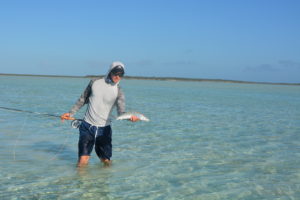
A small bone from the airport flats.
I spent the rest of my trip DIYing it wherever I could find a good flat on the island. There were few spots I could easily get to without a boat, but I managed to have some success on the western side of what they call the Airport Flats. To find this flat on the south side, you actually have to drive down a defunct runway and then along dirt roads to the shore. This area was good, however, I had a lot of trouble locating fish as the flat is large with little discernible structure. I would highly recommend a paddleboard or kayak to explore the other amazing flats that surround this one. Though I’m certainly no expert on bonefish and their habits, I have acquired a lot of adaptability to different fishing situations from competition fishing which helped me get a handle on the fishing in Exuma. I’ve included a short guide to the area below, so hopefully others can figure out the fish on the island as well.
What to Bring
Rods:
A 9 foot 7 or 8 weight was perfect depending on the wind. I think a 7 weight would be the perfect rod, as you can fairly close to the fish in exuma and the wind is usually not too bad, especially on the south side of the island where the wind is buffered. I used a Sage Salt HD 8 weight which did a great job, though had a little too much backbone for the average fish size in the area and made a bit too much disturbance on the water for my liking. Bringing two rods is a MUST as it’s very easy to nick a blank while casting in a cross wind, and there is nowhere to get a replacement on the island.
Reels and lines:
Any reel with a good drag, high retrieve rate, and low startup inertia will work. I used an Orvis Hydros, as it balance my rod well. You shouldn’t have to worry about fish taking too much backing, so as long as it holds the line and another couple yards you’ll be fine. I used the Rio Director Bonefish line which I like, though it seems overweighted by about half a line weight. Any good warm water line will do you well here, just make sure it doesn’t gum up in high temps.
Leader and tippet:
I was not a fan of the commercial bonefish leaders I tried as I felt they were not stiff and aggressive enough. I ended up using a formula I got from Deneki, which you can find here https://www.deneki.com/2010/12/bonefish-leaders/. It is five equal 2 foot sections of rio alloy hard mono going from 30lb, to 25lb, to 20lb, to 16lb, and then to anywhere from 4-10 feet of tippet. It cast very well in all conditions, though I would think about lengthening it slightly for calm waters. As for tippet, I used Seagaur 12lb InvisX the entire time. I’d say there are very few fish you could not land on that, however I brought 15lb just in case. The fish were not tippet shy in my opinion, but I stayed with 12lb to hedge my bets.
Flies:
These fish were not selective to pattern at all, the most important aspects of the fly were size and weight. I had a wide variety of patterns but used only 3 my entire trip: a simple tan Gotcha, the Strip-Tease, and a Gotcha with a little chartreuse mixed in for deeper or dirtier water. The sand here is very light, so tan and light tan were the most productive base colors. I fished them in sizes 6,4, and 2. Smaller sizes were fished in shallower water, and bigger ones in deeper. I had each fly tied with bead chain eyes, brass dumbbell eyes, and lead eyes in the appropriate size for the hook. Having them all my go to patterns in a wide array of sizes and weights allowed me to fish any water effectively. I like to be over prepared, it’s just how my competition mindset works, however you could easily fish the flats with a handful of flies in just a few sizes and weights.
One other thing I will add is the importance of tying or buying flies with great hooks. I used middle of the line hooks and had some flies that were on older, used hooks, and this led to a lot of dropped fish. The few flies I had tied on quality hooks gave me a much better hookup percentage than the others. I didn’t think much of it while preparing, however when I was on the flats, I realized that I put all that effort into getting to the fish just to lose so many due to bad hooks. Buy good hooks is definitely my number one piece of advice for bonefishing.
Extra Gear:
Be sure not to forget sun shirts, sun gloves, a good pair of sunglasses, and sunscreen as the UV index is high here. As far as footwear goes, I brought a pair of Orvis flats booties, which came in handy a few times but were generally unnecessary.
Where to stay:
There are a ton of places to stay on the island, however most are located on the north side. There is very limited opportunity for bonefishing on this side, and it can be accessed no matter where you stay. If I was to go back, I would definitely rent a place on the south side, where the best wading flats are located. Most of these flats can only be accessed for DIY fishing by crossing a deep, 100 yard channel between the island and the flats by kayak or paddleboard. If you get a rental on the south side, most will provide some sort of watercraft for you so you can access the flats. There is no other way to get a boat to access the flats than by renting one of these properties.
Where to eat:
The first thing you have to know about food (and water) on the island is that its EXPENSIVE. The island is only supplied by ship once a week on Tuesday, so everything is limited. Gas was $5.50 a gallon, water was $8 a gallon, a bag of chips was $4, and eating out was $15 a person even at the cheapest place I could find. I brought a lot of non perishable groceries with me from the US, like jerky and pretzels, but looking back I should have brought more. The two nicest grocery stores I found were Smitty’s and Exuma Market, as they were stocked the best.
As far as restaurants go, there were a lot of good ones and a ton that I did not get the chance to try. My favorite area to eat was called the Fish Fry. This was a large plaza with a bunch of small restaurants and bars all clustered together. The most popular one here was Shirley’s, which had a dessert called guava pie that I would kill to get here in the states. Others I would recommend are Eddie’s Edgewater, Sonia’s, Peace and Plenty, and Mike’s Pizza. My favorite restaurant by far was Chat and Chill, which sadly was not on the main island. It was a $15 ferry ride away on stocking island, but if you have time, I would recommend checking it out. It had the best conch salad in the area, which you should definitely try if you’re feeling adventurous. Try cooking for yourself as much as possible to save some money as all of the restaurants are pricey for what you get.

Guava pie – the best!!
Where to fish:
Here is a map of the spots I found for walking out with no boat at all:
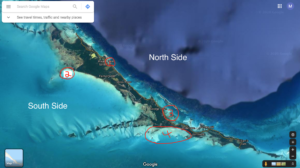
1.) This area is a beach called Cocoplum, right in front of the Sandals resort. It is a smaller and slightly deeper flat that has a lot more chop and is more affected by the weather. It is completely unfishable on high tide, and I did not think it was very promising. When I fished it, I didn’t see any fish, however I included it here because it’s easy access to check out and was recommended by a few people.
2.) This is an area that was recommended by my guide Herman. Access is very difficult and is all dirt road driving off Queens Highway. It looks very good and has fish, but getting to the good part of it requires some walking. Worth a look if you have extra time.

3.) This is the Crab Cay/February Point area.
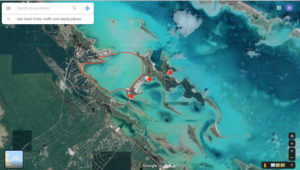
There are many good small flats surrounding the cay. Three of which that I checked out and would recommend trying are marked in red. The outlined area was recommended to me by multiple people but I didn’t fish it. It looks good and is wadable for a good bit off the shore, most notably in the upper left side.
4.) Last but not least, this area is the airport flats.
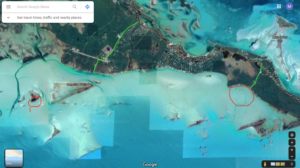
The section on the right is where I was able to access the flat right from the highlighted road. This is just a small window into this vast flat, however. I fished other parts on the boat with the guide, and wish I had had more time to see the rest of it. The longer highlighted road is the access point where my guide put his boat in, and the smaller red circle is the mangrove where I encountered the enormous school.
Hopefully this makes finding good fish a little easier for anyone planning a trip to Exuma. If anyone has any further questions please feel free to reach out and i’ll do my best to answer them. Don’t forget, I’ve begun booking trips for this year with dates available now. Tight lines everyone!
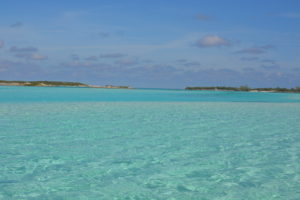
A little paring shot if you need more convincing to check out Exuma! You can’t beat the views.

Great write up. Looks like fun!